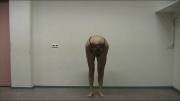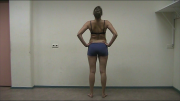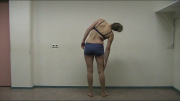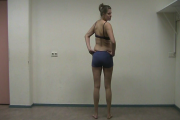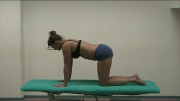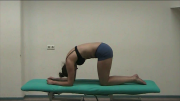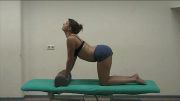These movements are performed in standing. The therapist should observe the patient’s willingness to perform the movement, differences in range of motion (ROM) and any compensation mechanisms. Painful movements should be performed last. During the movements, look for movement limitations and possible causes, including pain, spasm, stiffness, or blocking (Magee, 2006).
Flexion: 40-60 degrees of movement, watch for compensatory movements in thoracic spine. The normal lumbar lordosis should flatten. Watch for jerky or painful movements, and note how far forward the patient performs the flexion.
k
k
Extension: 20-35 degrees of movement, patient must place hands on hips in order to stabilize the movement and not compensate with pelvic movements.
k
k
Lateral Flexion: 15-20 degrees, patient runs their hand down the side of the leg while attempting not to make any forward or backward movements. Compare with other side and note amount of rotation performed together with the flexion.
k
k
Rotation: 3-18 degrees, can be performed in standing or sitting (to eliminate compensatory hip movement).
(Magee 2006)
k
k
There are other ways to perform active range of motion, like in sitting and in the quadruped position. The authors think that the quadruped position is clearly showing the deviation from the norm.
Quadruped Flexion-Extension: The patient is asked to position himself on his hands and knees, imitating the position of a cat. The shoulders, wrists, hips and knees are put in a 90 degrees angle, the back is straight. From this initial position, the patient is asked to flex as much as possible the whole spine, without any compensatory movements in elbows or any other joint. After several seconds, ask the patient to go back to the initial position and then to fully extend the whole spine. Again, the initial position is restored after several seconds.
I
Quadruped Flexion: A deviation of the test is to position the patient on his elbows, thus lowering the upper body. In this position, lumbar flexion is greatest, as well as thoracic extension.
I
I
Quadruped Extension: If the patient’s hands, and so the upper body, are lifted, lumbar extension is greatest, as well as thoracic flexion.
I
I
Patient history
Observation
Passive range of motion (PROM)
Neurological testing
